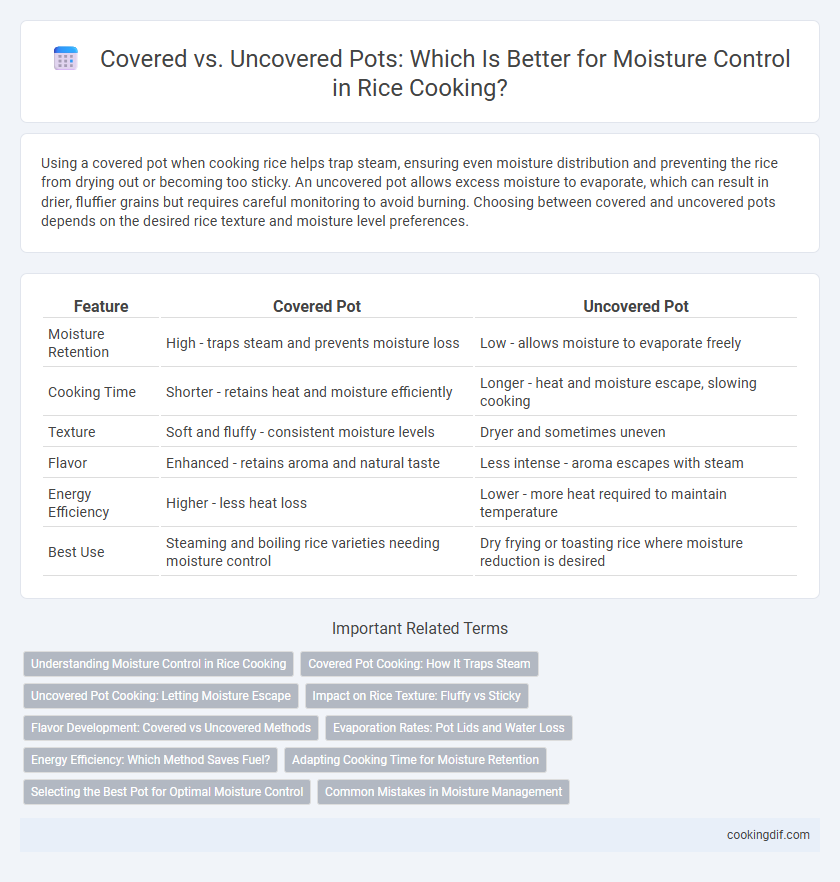Using a covered pot when cooking rice helps trap steam, ensuring even moisture distribution and preventing the rice from drying out or becoming too sticky. An uncovered pot allows excess moisture to evaporate, which can result in drier, fluffier grains but requires careful monitoring to avoid burning. Choosing between covered and uncovered pots depends on the desired rice texture and moisture level preferences.
Table of Comparison
| Feature | Covered Pot | Uncovered Pot |
|---|---|---|
| Moisture Retention | High - traps steam and prevents moisture loss | Low - allows moisture to evaporate freely |
| Cooking Time | Shorter - retains heat and moisture efficiently | Longer - heat and moisture escape, slowing cooking |
| Texture | Soft and fluffy - consistent moisture levels | Dryer and sometimes uneven |
| Flavor | Enhanced - retains aroma and natural taste | Less intense - aroma escapes with steam |
| Energy Efficiency | Higher - less heat loss | Lower - more heat required to maintain temperature |
| Best Use | Steaming and boiling rice varieties needing moisture control | Dry frying or toasting rice where moisture reduction is desired |
Understanding Moisture Control in Rice Cooking
Using a covered pot during rice cooking helps trap steam and retain moisture, resulting in evenly cooked, fluffy rice. An uncovered pot allows excess moisture to escape, which can lead to drier, less tender grains but offers better evaporation control to prevent overcooking. Optimal moisture control in rice cooking involves balancing steam retention with evaporation based on the desired texture and rice variety.
Covered Pot Cooking: How It Traps Steam
Covered pot cooking for rice creates a sealed environment that traps steam, maintaining consistent moisture and heat levels essential for even cooking and fluffy texture. The trapped steam condenses on the lid, continuously moistening the rice grains and preventing dryness. This method enhances flavor retention and reduces cooking time by utilizing the steam's uniform heat distribution.
Uncovered Pot Cooking: Letting Moisture Escape
Cooking rice in an uncovered pot allows steam and excess moisture to escape, preventing sogginess and promoting a fluffier texture. This method is especially effective for long-grain rice varieties, where controlling moisture is crucial to avoid clumping. Uncovered pot cooking ensures that the rice grains remain separate by reducing condensation buildup during the simmering process.
Impact on Rice Texture: Fluffy vs Sticky
Using a covered pot traps steam, resulting in rice grains absorbing more moisture and yielding a stickier, more cohesive texture ideal for dishes like sushi or risotto. An uncovered pot allows excess moisture to evaporate, producing fluffier, separated grains preferred in pilafs or biryanis. Moisture control through pot coverage directly influences the final rice texture by regulating steam retention and evaporation during cooking.
Flavor Development: Covered vs Uncovered Methods
Using a covered pot traps steam and moisture, promoting even cooking and enhancing the rice's natural flavors by allowing the grains to absorb aromatic compounds fully. Cooking rice uncovered lets excess moisture evaporate, which can concentrate flavors but may result in drier, less tender grains. For optimal flavor development, covered cooking maintains moisture and releases subtle, well-rounded taste profiles, while uncovered methods produce a nuttier, chewier texture with intensified aroma.
Evaporation Rates: Pot Lids and Water Loss
Covered pots significantly reduce evaporation rates during rice cooking, maintaining optimal moisture levels and enhancing grain texture by trapping steam and heat. Uncovered pots lead to higher water loss, increasing the risk of uneven cooking and dry, less fluffy rice due to constant steam escape. Efficient moisture control through pot lids is crucial for consistent rice quality and energy conservation.
Energy Efficiency: Which Method Saves Fuel?
Cooking rice in a covered pot retains steam and heat, significantly reducing cooking time and fuel consumption by minimizing heat loss. Uncovered pots allow moisture and heat to escape, requiring longer cooking periods and higher energy expenditure. Utilizing a covered pot maximizes energy efficiency, conserving fuel while ensuring proper moisture control.
Adapting Cooking Time for Moisture Retention
Using a covered pot traps steam and moisture, reducing cooking time and ensuring rice stays tender and fluffy by absorbing consistent moisture. An uncovered pot allows water to evaporate, requiring longer cooking times to avoid undercooked grains, but risks drying out the rice if not monitored closely. Adjusting cooking time based on pot coverage is crucial for achieving optimal moisture retention and desired rice texture.
Selecting the Best Pot for Optimal Moisture Control
Selecting the best pot for cooking rice hinges on moisture control, where covered pots trap steam effectively, ensuring even cooking and preventing dryness. Uncovered pots allow excess moisture to evaporate, ideal for recipes requiring drier texture or fluffy rice. For optimal results, choose a covered pot made from materials like heavy-duty aluminum or stainless steel to maintain consistent heat and moisture levels.
Common Mistakes in Moisture Management
Using an uncovered pot during rice cooking often leads to excessive moisture evaporation, causing uneven texture and undercooked grains. Common mistakes include failing to seal the pot properly, which lets steam escape and increases cooking time, or using excessive water that results in mushy rice. Proper moisture control depends on maintaining a consistent steam environment with a tightly covered pot to ensure even absorption and fluffy rice consistency.
Covered vs Uncovered pot for moisture control Infographic

 cookingdif.com
cookingdif.com